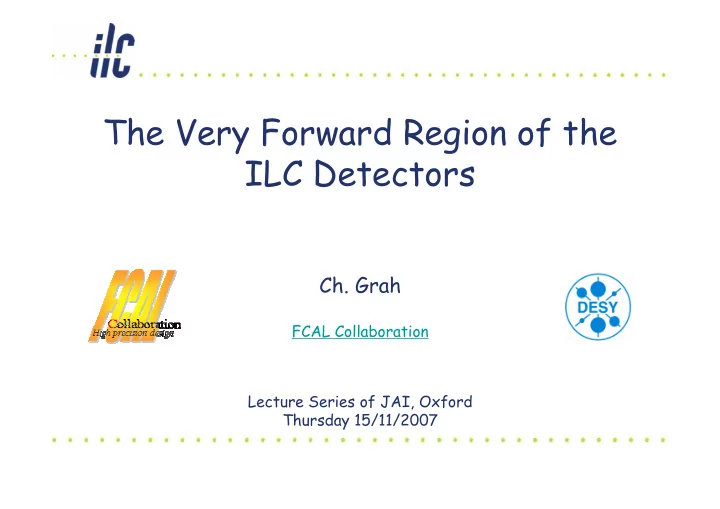

The�Very�Forward�Region�of�the� ILC�Detectors Ch.�Grah FCAL�Collaboration Lecture�Series�of�JAI,�Oxford Thursday 15/11/2007
Contents � The�FCAL�Collaboration � Forward�Calorimetry Overview – ��������������������������� � Beamdiagnostics using�BeamCal�and�GamCal � R&D�of�the�FCAL�Collaboration:� – ���������� – ��������������� � Summary 15/11/2007 ����������������������� 2
������ �������!������� ������ �������!������� "#�$����������%����"&����������' � ������ �%����������(����� � �)�*��+��������%�������������������������,��-�� � ����-��+���.����������!��*/��� Supported�by: � ���0 � EUROTeV,� � $����������%�.�������(��������( ���,��-�� � 1�����$���������.�������������������!�� � EUDET,� � ��!�������������� ��2�2����������2������3���� � NoRHDIA � .����������������%�(������� ��)�(��4���- � INTAS � ������)��������*��+�������������� � DOE � ���� +�+�*��+������ � ISF � University�of�Colorado,�Boulder � Fital � �$.� �$���5��%�.������ ������������������ � Yale�University,�New�Haven � ���/��������������� ����������%����*��+������ http:// www7zeuthen.desy.de/ILC/fcal / 15/11/2007 ����������������������� 3
The�International�Linear�Collider ~30km Parameters: 500�GeV (1�TeV upgrade�possible) 2�x�10 6#� cm 78 sec 7" electron�polarization�~80�% positron�polarization�~30�%�(60�%) beam�sizes:� σ 9 ≈ 600nm,� σ �� ≈ 6nm, σ : =�300 � m 15/11/2007 ����������������������� 4
Design�of�the�Forward�Region GamCal ~185m BeamCal LumiCal ILC�RDR 15/11/2007 ����������������������� 5
Tasks�of�the�Forward�Region ECal and�Very�Forward�Tracker�acceptance�region. •Precise�measurement�of�the� integrated�luminosity�( � L/L�~�10 7# ) •Provide�27photon�veto d a r m 0 •Provide�27photon�veto 5 1 ~ •Serve�the�beamdiagnostics using�beamstrahlung�pairs d a r m 0 4 ~ 5mrad •Serve�the�beamdiagnostics using�beamstrahlung�photons IP ����������'� High�precision,�high�occupancy,�high�radiation�dose,�fast�read7out! 15/11/2007 ����������������������� 6
Forward�Region�(LDC) BPM�for�FONT BeamCal Si7pixel Space�for�cables QD0 LumiCal Vacuum�Pump Space�for� Graphite� electronics/connectors Shielding�Tube cooling 15/11/2007 ����������������������� 7
Forward�Region�Overview LDC SID � The�FCAL�Collaboration� develops�the�Very�Forward� R Inner R Outer Z Pos R Inner R Outer Z Pos Detectors:� LumiCal,�BeamCal�and� mm mm mm mm mm mm GamCal. LumiCal 80 350 2270 60 200 1800 BeamCal 20 165 3550 16 110 3000 � Due�to�the�small�bunch�size� GamCal 7 7 ~185m 7 7 ~185m σ x ~650nm,� σ y ~5.7�nm�and� the�high�bunch�charge,�� N�x�10 10 /bunch,� beamstrahlung�becomes� important�at�the�ILC. LDC�20mrad � The�geometry�has�to�be� carefully�optimized�to� minimize�background�due�to� the�beamstrahlung�pairs. 15/11/2007 ����������������������� 8
The�LumiCal Precise�Measurement�of�the�ILC‘s luminosity 15/11/2007 ����������������������� 9
Precise�Measurement�of�the�Luminosity� � Required�precision�is: � L/L���~�10 7#� (GigaZ 10 ; /year) � L/L���<��10 76 (e < e 7 � W < W 7 10 = /year) � L/L���<��10 76 (e < e 7 � q < q 7 10 = /year) BeamCal LumiCal � Bhabha�scattering�ee7>ee( γ )�is�the�gauge�process: – ���������!����+���������������-���������/�������������>?���>�.@ σ – )�����������������������������>?�. ���!�� A�"@ θ 6 – B����-���������������������/�������C��('�"& 76 D'�������������������������� ��������������������������������������AE�"& 7# 5 15/11/2007 ����������������������� 10
Physics�Background�and�Beam7Beam�Effect 27photon rejection BHSE 27photon�events�are�the�main�background. � We�determined�an�efficient�set�of�cuts�to� � reduce�the�background�to�the�level�of�10 7# . The�Bhabha�Suppression�Effect�(BHSE)�is�due� � to�the�EM�deflection�and�energy�loss�by� beamstrahlung�of�the�Bhabhas.�Correction� needs�precise�knowledge�of�beam�parameters. C.Rimbault et�al.�JINST�2:O9001.2007 15/11/2007 ����������������������� 11
LumiCal�Design Si/W�sandwich�calorimeter,� 2�half�barrels,�30740 layers laser�position�monitoring�system Single�detector�layer 48�azimuthal�sectors, each�sector�subdivided�into�radial� pads�of�about�1�mrad Each�layer�consists�of� 3.5mm�tungsten�absorber, 300 � m�silicon�sensor�and�readout. 15/11/2007 ����������������������� 12
Requirements�on�the�Mechanical�Precision MC�simulations�of�LumiCal:� Derive�requirements�on�design,�segmentation,�mechanical�precision� and�impact�of�different�magnetic�field/crossing�angles. � L/L 1.0�10 7# inner�radius 4.2�Om radial�offset 640�Om distance 300�Om 15/11/2007 ����������������������� 13
LumiCal:�Systematics Headon,�14,20�mrad X7angle�outgoing�beam 14�mrad X7angle�detector�axis 20�mrad X7angle�detector�axis� Recommendation:� place�LumiCal�around�outgoing� beam�and�tilt�it�accordingly. 15/11/2007 ����������������������� 14
Laser�Alignment�System Two�laser�beams�allow�to�measure displacements�in�xyz. 0,8 Background cut=15 σ x� =�0.5� � m 0,6 Background cut=25 Background cut=50 σ z� =�1.5� � m Background cut= 90 0,4 0,2 0 σ x [µm] -0,2 Temperature�stability�is�an�issue. -0,4 Observed�changes�of�about�1 � m/K. -0,6 -0,8 Integration�study�for�the�LAS�started. -1 -1,2 0 100 200 300 400 500 600 700 800 900 1000 x displacement [µm] 15/11/2007 ����������������������� 15
The�BeamCal Particle�Veto�at�Lowest�Polar�Angles 15/11/2007 ����������������������� 16
BeamCal�Design � Compact�em calorimeter�with�sandwich� structure: � 30�layers�of�1�X 0 o3.5mm�W�and�0.3mm�sensor BeamCal � Angular�coverage�from�~5mrad�to�~45�mrad � Moliére radius�R M ≈ 1cm LumiCal � Segmentation�between�0.5�and�0.8�x�R M W�absorber�layers Radiation�hard�sensors with�thin�readout�planes BeamCal Space�for�readout�electronics 15/11/2007 ����������������������� 17
BeamCal�Challenges � BeamCal�will�extend the�sensitive�region to�lowest�polar�angles. � Challenge: Detect�single�high� energetic�particle on�top�of�a� background�of�10 4 low� energetic�e + e 7 pairs. Physics�signal:� � BeamCal�serves�also�as� e.g.�SUSY�smuon production part�of�the�beam� diagnostics�system,� providing�a� Background�signal:� ‘beamstrahlung�pair’ 27photon�event,�may�fake information�to�the� the�upper�signal�if�the�electron feedback�system. is�not�detected. 15/11/2007 ����������������������� 18
Recommend
More recommend